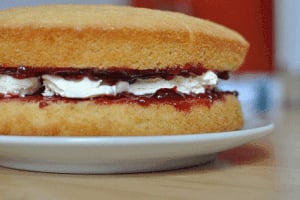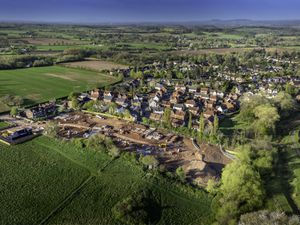Diamond Jubilee recipes to dine like a Queen
If you fancy dining like the Queen this weekend then why not try some of the recipes that have a royal connection. CATHY SPENCER reports.

If you fancy dining like the Queen this weekend then why not try some of the recipes that have a royal connection. CATHY SPENCER reports.
This weekend thousands of people will be making picnics and joining in one of the Jubilee lunches planned across the West Midlands.
To give your picnic a bit of style, why not make one of the recipes that have been enjoyed by the royal family for generations.
If you want to get a real taste of what it is like to be the Queen then her favourite cake with her afternoon tea is reportedly chocolate biscuit cake.
Even guests at William and Kate's wedding reception indulged in a multi-tiered chocolate biscuit cake at the request of the prince, who is said to have developed a soft spot for the treat.
The newlyweds commissioned biscuit maker McVities to craft the chocolate creation made from 1,700 biscuits and nearly 20kg of chocolate.
The Victoria sponge cake was named after Queen Victoria, who liked a slice of it with her afternoon tea.
It was actually Anna, the Duchess of Bedford who came up with the idea of afternoon tea when she was one of Queen Victoria's ladies-in-waiting.
Because the noon meal had become skimpier, the Duchess suffered from "a sinking feeling" at about 4pm.
Adopting the European tea service format, she invited friends to join her for an additional afternoon meal at 5pm in her rooms at Belvoir Castle.
The menu centered around small cakes, bread and butter sandwiches, assorted sweets and, of course, tea.
Queen Victoria adopted the new craze for tea parties and by 1855, the Queen and her ladies were in formal dress for the afternoon teas.
The Victoria sponge cake was one of the queen's favourites. After her husband, Prince Albert, died in 1861, the Queen spent time in retreat at Osborn House on the Isle of Wight.
According to historians, it was here that the cakes were named after her.
Constance Spry, a florist, and Rosemary Hume, a chef, are credited with the invention of coronation chicken.
Preparing the food for the banquet of the coronation of the Queen in 1953, Spry proposed the recipe of cold chicken, curry cream sauce and dressing that would later become known as coronation chicken.
Coronation chicken may have been inspired by jubilee chicken, a dish prepared for the silver jubilee of George V in 1935, which mixed chicken with mayonnaise and curry.
Additionally, for the Queen's Golden Jubilee in 2002, another celebratory dish was devised which was also called Jubilee chicken.
When President Eisenhower visited the Queen at Balmoral in 1960, he was so impressed with her "homemade" drop scones that he asked for the recipe.
Weeks later, Her Majesty sent the US President some neatly-typed instructions.
Beef Wellington is reportedly named after the Duke of Wellington and it is a firm favourite at Buckingham Palace.
According to former royal chef Darren McGrady, who worked for the Queen for 15 years until 1997, Her Majesty loves the dish, which combines meat with mushrooms and puff pastry.
Battenburg cake is a British favourite and the chefs of the British Royal Family were introduced to this German style of cake making during Queen Victoria's reign,
The first Battenberg cake was made to celebrate the wedding of Queen Victoria's granddaughter, Princess Victoria of Hesse and by Rhine, and was named after her husband to be, Prince Louis of Battenberg.
Chocolate biscuit cake:
Ingredients:
4 oz dark chocolate for the cake.
4 oz granulated sugar.
4 oz unsalted softened butter.
1 egg.
8 ounces Rich tea biscuits.
Half a teaspoon of butter for greasing.
8 ounces dark chocolate for coating
1 ounce chocolate for decoration
Lightly grease a six inch by two-and-a-half inch cake ring and place on a tray on a sheet of parchment paper. Break each of the biscuits into almond size pieces by hand and set aside. Cream the butter and sugar in a bowl until the mixture starts to lighten. Melt the four ounces of chocolate and add to the butter mixture whilst constantly stirring. Beat in the egg to the mixture.
Fold in the biscuit pieces until they are all coated with the chocolate mixture. Spoon the mixture into the prepared cake ring. Try to fill all of the gaps on the bottom of the ring because this will be the top when it is un-moulded. Chill the cake in the refrigerator for at least three hours.
Remove the cake from the refrigerator and let it stand while you melt the eight ounces of chocolate. Slide the ring off the cake and turn it upside down onto a cake wire. Pour the melted chocolate over the cake and smooth the top and sides using a palette knife. Allow the chocolate to set at room temperature. Carefully run a knife around the bottom of the cake where the chocolate has stuck it to the cake wire and lift it onto a tea plate. Melt the remaining one ounce of chocolate and use to decorate the top of the cake.
Coronation chicken:
Ingredients:
Shredded chicken from a medium sized pre roasted chicken
3 tbsp mayonnaise
Mild curry powder to taste
Half a teaspoon of cinnamon
Ground Black Pepper
1 tbsp mango chutney
Sultanas - as many as you fancy
Mix the mayo, curry powder, cinnamon, black pepper, chutney and sultanas together. Altering quantities to your preferred taste mix the combined ingredients with the shredded chicken.
Victoria sponge cake:
Ingredients:
Unsalted butter, softened, plus a little more for greasing
4 eggs
Golden caster sugar
Self-raising flour, sieved with a pinch of salt
1 tsp vanilla extract
A little milk, if necessary
Raspberry jam
Whipping cream
Icing sugar or caster sugar, for dusting
Heat the oven to 180C/350F/gas mark 4. Lightly grease two 20cm sandwich cake tins with butter, and line the bases of each with baking parchment.
Weigh the eggs in their shells and weigh out the same amount of butter, sugar and flour. In a bowl, beat the butter until creamy, and then beat in the sugar until light and fluffy. Add the eggs one at a time, beating well after each addition, adding a tablespoon of sifted flour if the mix looks as if it's going to curdle. Beat in the vanilla extract, then gently but thoroughly fold in the flour. Now check the consistency of the batter. Scoop up a tablespoon of the mixture and hold it over the bowl. If it drops down fairly easily, it's just right. If it sticks stubbornly in the spoon, fold a tablespoon or two of milk into the mixture.
Divide the batter equally between the two tins and gently smooth the tops with a knife. Bake for 25-30 minutes, until a toothpick inserted into the centre comes out clean. Leave to cool in the tin for a couple of minutes, then turn out on to a wire rack to cool completely.
Turn one of the cakes upside down on a plate, so the flat surface is uppermost. Spread generously with raspberry jam. Spread a good layer of whipped cream on the flat surface of the second cake and sandwich the two together. If you like, dust the surface with icing sugar or caster sugar before serving.
Beef Wellington:
Ingredients:
1 oz/25g butter
1 onion, peeled and finely chopped
5oz/150g chestnut mushrooms, finely chopped
2 cloves garlic, minced
3 tbsp flat leaf parsley, finely chopped
3 ½ oz/ 100g smooth liver pate
1 ½ lb/750g beef fillet
salt and ground black pepper
1lb/500g ready-made puff pastry
1 egg, beaten to glaze
Heat the oven to 400F/200C/Gas 6. Melt the butter in a large frying pan and cook the onion for about five minutes until it is beginning to soften. Add the mushrooms and cook for a further five minutes until soft and creamy. Stir in the garlic and parsley and season with a little salt and pepper. Set aside to cool. Beat the pate into the mushroom mixture and set aside.
Roll out the puff pastry on a lightly floured surface to a sheet large enough to enclose the beef, reserving the offcuts for decoration. Spread the pate mixture down the middle of the pastry and lay the beef on top of the mixture.
Brush the edges of the pastry with beaten egg and fold the pastry over the meat to enclose it in a neat parcel, sealing the edges well. Place the meat parcel on to a baking sheet, seam side down,
Cut decorative leaves from the reserved pastry. Brush the parcel with beaten egg, decorate with the leaves and chill for about 10 minutes. Bake for 40 - 45 minutes until the pastry is golden and puffed up. Transfer to a serving board and leave to stand for 10 minutes. Serve cut into thick slices.
Image via Flickr courtesy of gordonplant





